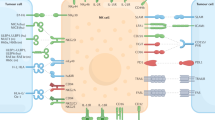Abstract
Single-cell suspensions prepared by enzymatic disaggregation of an immunogenic 3-methylcholanthrene-induced sarcoma (Mc40A) contain a significant proportion of infiltrating leucocytes (approximately 42%), comprising T lymphocytes, macrophages and non-phagocytic FcR+ lymphoid-like cells. Tumour-infiltrating lymphocytes (TIL) were isolated and purified by successive passage over Sephadex G-10 columns and their cytotoxic activity in vitro compared with that of lymphoid cells from normal rats and from tumour-bearers at different times after implantation. For this purpose, surviving target cells were quantified by incorporation of the gamma-emitting analogue of methionine, 75Sel-methionine, in a 48-h assay which detected both cytotoxic and cytostatic effects. The reactivity of TIL, which was consistently demonstrable from 11 days after tumour transplantation, was essentially similar to that of normal splenic lymphocytes in magnitude and specificity. Reciprocal cytotoxicity tests using TIL and cultured targets from an antigenically unrelated tumour of similar aetiology (Mc57) showed that the manifestation of TIL cytotoxicity was determined, not by the tumour of origin, but by the susceptibility of the target cells. Evidence that the effector function of TIL was mediated in part by natural killer (NK) cells was derived from concurrent experiments using human myeloid cells (K562) as targets in an 18h 51Cr-release assay. In this system the level of NK activity was critically dependent on the numbers of tumour cells in the TIL population; contamination in excess of 2% gave rise to dose-dependent inhibition of NK function. The results show that within a progressively growing tumour known to possess rejection antigens, NK reactivity was detected in the absence of a demonstrable tumour-specific cytotoxic component.
This is a preview of subscription content, access via your institution
Access options
Subscribe to this journal
Receive 24 print issues and online access
$259.00 per year
only $10.79 per issue
Buy this article
- Purchase on Springer Link
- Instant access to full article PDF
Prices may be subject to local taxes which are calculated during checkout
Similar content being viewed by others
Rights and permissions
About this article
Cite this article
Moore, K., Moore, M. Systemic and in-situ natural killer activity in tumour-bearing rats. Br J Cancer 39, 636–647 (1979). https://doi.org/10.1038/bjc.1979.115
Issue Date:
DOI: https://doi.org/10.1038/bjc.1979.115
This article is cited by
-
The Tumor Microenvironment: The Making of a Paradigm
Cancer Microenvironment (2009)
-
Characteristics of NK cells in Syrian hamsters with tumors differing in metastatic and resistance-inhibiting activity
Bulletin of Experimental Biology and Medicine (1985)
-
The seeding of a transplanted murine leukemia and its influence on hemopoietic stem cells and immune function of the host
Journal of Cancer Research and Clinical Oncology (1983)
-
Analysis of natural killer activity and antibody-dependent cellular cytotoxicity in healthy volunteers and in patients with primary lung cancer and metastatic pulmonary tumors
Journal of Cancer Research and Clinical Oncology (1982)



